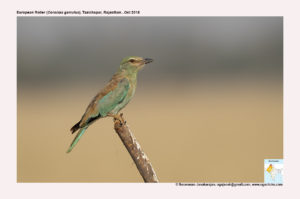European Roller

Eurasian Roller Coracias garrulus
Etymology:
- Coracias : Greek word for Crow like
- Garrulus: Latin word for chattering, babbling, Nosiy
Vernacular Names: Baluchistan: Sabzkarask, Kash: Nilakrash, Guj: Kashmiri chash, Kashmiri neelkanth, Mar: European nilpankh
Distribution in India: Passage migrant in North West of India. Also see throughout the country in select spots.
Description: Size of 31–32 cm; wt. of male 127–160 g, female 130–154 g. It is a large roller without tail-streamers, proportionately larger-headed than most congeners, and in flight appears long-necked. The nominate race with head, neck and underparts are light blue; whitish around base of bill, and short, thin blackish eyestripe; rufous-brown upperparts, with back, rump and tail-coverts as ultramarine-blue; wing-coverts are greenish-blue, marginal ones are purple, primary coverts and bases of primaries are azure-blue; remiges are black, with purple only on inner secondaries, and underside bright violet-blue; tail is greenish-blue with darker base, central feathers are greyish, outermost tipped black and slightly longer than rest. .Both the sexes are alike. The immature has duller, head and tail is olivaceous-green, breast and lesser wing-coverts are tinged rufous, cheeks and chin to breast are narrowly streaked with white; tail lacks black corners. Race semenowi is slightly paler than nominate
Habitat: It is found in in open countryside with patches of oak forest, mature pine woods with heathery clearings, orchards, mixed farmland, broad river valleys, and dissected plains with scattered thorny or leafy trees. On African wintering grounds, inhabits dry wooded savanna and bushy plains, in Tanzania also sisal fields and clearings in montane forest, and savanna woodland. It is found from warm sunny lowlandsup to 3000 m.
Food Habits: They eat Invertebrates, mainly beetles and other hard-bodied insects, and some small vertebrates: beetles, locusts, grasshoppers, mantises, cicadas, Hymenoptera, termites, butterflies, caterpillars and flies; scorpions, centipedes, millipedes, spiders, molluscs, earthworms, frogs, slow-worms ,lizards, snakes, voles, shrews and exhausted small . Also eats fruits like grapes and figs .It forages mostly from elevated perch, watching ground intently. It also does fly-catching from perch, following plough on farmland, and even sustained aerial hunting like a swallow.
Breeding Habits: The breeding season is May-July. They display when perched include bill-up displays, bowing, allopreening, wing drooping and tail fanning. Holes created by woodpeckers or wood boring insects in palms are favoured for nesting in some areas. The nest cavities may also be made by tearing open rotten tree trunks or in cavities in building. The cavity is usually unlined and is made up mainly of debris from the wood. The normal clutch consists of about 3-5 eggs. Both sexes incubate the eggs for about 17 to 19 days. The fledging period is 25–30 days. The young fledge and leave the nest after about a month.